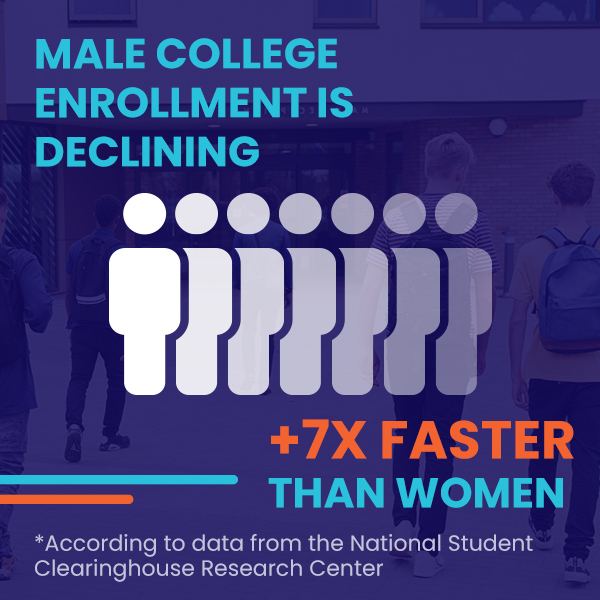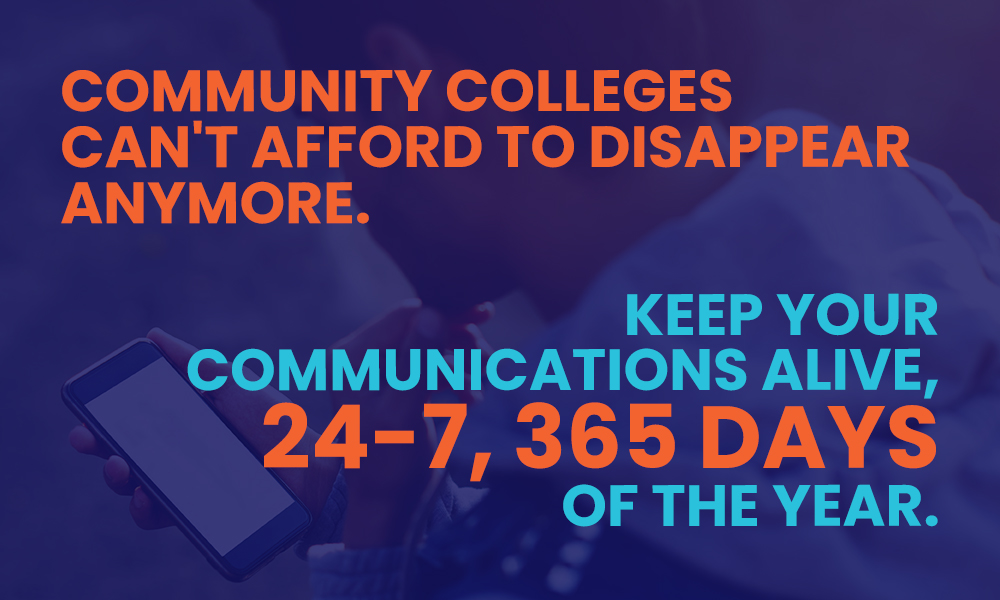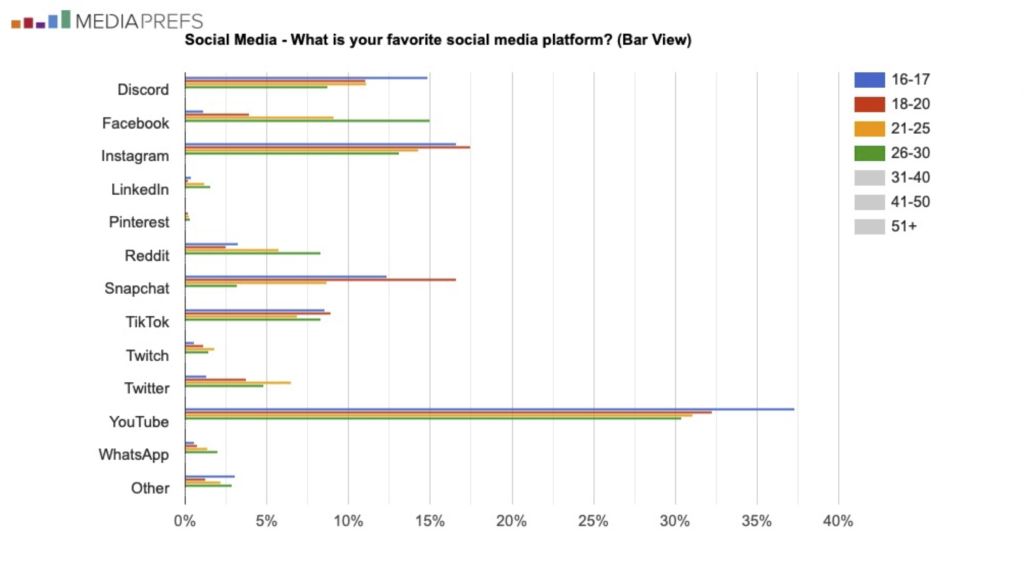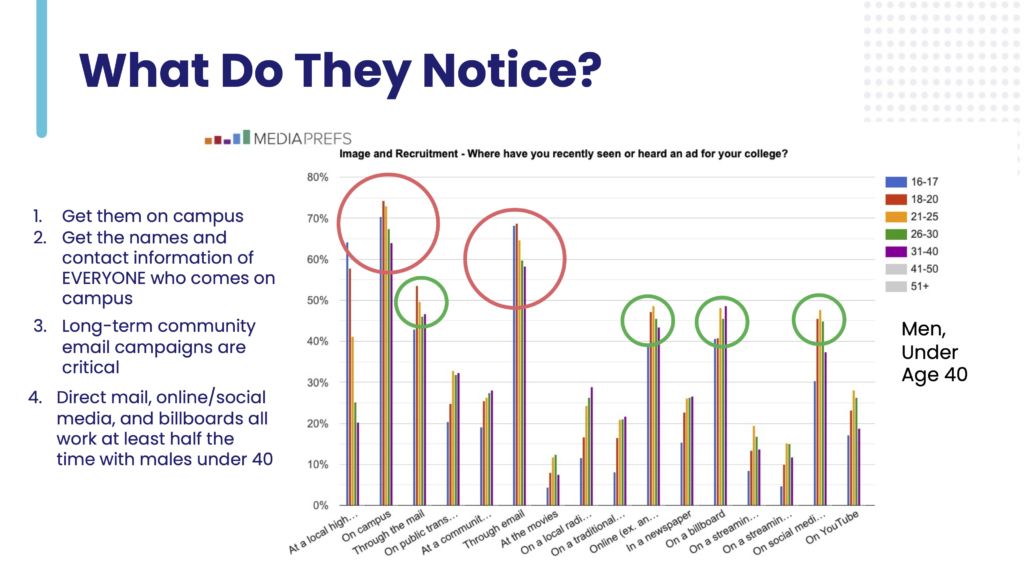Long before March 2020, male student enrollment was in trouble at community colleges.
“The pandemic did not help any of us — enrollment was already going badly before the pandemic hit,” says our CEO, Dr. Pam Cox-Otto. And when it comes to male student enrollment, the numbers had been plummeting for a long time.
“As early as 15 years ago, when we began our Media Preferences research, we saw that young men were not engaging at the same numbers as women were,” says Cox-Otto.

Currently, the male student enrollment drop is more than seven times as steep as the decline among women, according to data from the National Student Clearinghouse Research Center. And the data also shows that in the population aged 25 to 34, women are completing their degrees by nearly 10 percent more than men. Confides Cox-Otto, “When you look at the community college numbers from our clients, I can tell you, it’s an even wider gap.”
To make matters worse, men of color are leaving community college at much faster rates, creating a huge drop in diverse populations. From fall 2019 to fall 2021, Black male student enrollment declined by nearly 24 percent, while Native American male enrollment declined by almost 26 percent, according to New America.

To address this steep loss, we must understand why men are leaving education. Only then can we leverage effective campaigns and place them on the right channels.
Why Are Male Students Leaving Community Colleges?
During the pandemic, hands-on technical colleges were much harder hit. After all, it’s more challenging to teach subjects like construction online. Plus, male students struggle more than women in virtual learning environments. Lastly, a lack of access to the internet and technology was a major issue that kept students from taking online courses.
But even as classes return to campus, young men are still not finding college climates and services tailored to them. For example, there’s nothing wrong with having a majority of female counselors and advisers. However, that ratio does mean you might be creating more of a feminized campus environment.
What Are We Doing Wrong with Male Student Outreach?
Similarly to counselors, recruiters are frequently mismatched for targeted demographics.
When predominately white recruiters go into communities of color …
Or women are trying to recruit male students …
… It’s not a good match for outreach.
The pandemic made it difficult for colleges to recruit ambassadors and peer recruiters. That’s why it’s a critical area to focus on now.
You also need to ensure that marketing and outreach efforts aren’t done in silos. Make sure you’re controlling both the “air game,” or marketing, as well as the face-to-face. If you don’t coordinate and integrate these efforts, your message will not ring true, and students will not enroll.
What Are the Outreach Solutions to Bolster Male Student Enrollment?
1. Keep Your Marketing Alive 24-7, 365
For many colleges, your marketing is loudest in April and May, followed by June, July, and August. Yet, as soon as the semester starts, you go quiet. But community colleges can’t afford to disappear anymore. Keep your communications alive, 24-7, 365 days of the year.

Why? Our Media Preferences research shows that it now takes nine to 12 months to convince potential students to attend college. And this hesitancy makes sense in the current climate of uncertainty and high risk.
“You have to commit to year-round marketing,” counsels Cox-Otto. “Men are slower to make up their minds, which is why you have to always be targeting them, particularly in communities of color.”
2. It’s Not All About Making More Money

When crafting messages, you must demonstrate that students will be able to earn more. But remember, it’s not all about the money. It’s also about having more choices!
So, make sure your messaging includes how education ensures greater earning power as well as greater opportunities, and you’ll make a much stronger argument.
3. Craft Messages for Male Students

In community college advertising, a common pitfall is that much of the messaging is feminine. The campaigns focus on quiet feelings, with motivation based on home and family. However, men are very sensitive to gendered ads. They are much less responsive to messages that they think are feminine.
Instead, try employing gender-neutral or male messaging. This advice might sound a little funny. But the reality is that women are used to living in a gendered, masculine world. Women aren’t put off by male messaging nearly as much as men are by female communications.
“Look at your messaging,” advises Cox-Otto. “If it’s soft and squishy with a feminine focus, you need to at least go gender-neutral.”
4. Include Images of Men to Boost Student Enrollment
Remember to include images that potential young male students can relate to.

In your advertising, using dynamic, powerful language while representing young men at college can help move the needle.
“We tend to make sure we are showing diversity, for example, having young and old students,” says Cox-Otto. “But many times, we ignore the need for balance in showing males in these pictures.”
5. The Best Ways to Reach Male Students

Finally, send messages where men are most likely to see them. And men are more engaged in using the internet than women, according to the Pew Research Center. Since men spend a lot of time online, that’s where you should focus campaigns. According to our Media Prefs research, YouTube is the premier platform to reach young men.

The next best way to reach young men is via email. Make sure to collect email addresses from everyone who visits campus, whether they are a potential student or influencer. Encourage your community to come to campus, and make sure you never miss an opportunity to gather information.

Third, direct mail, social media, and billboards work with males at least half of the time. Don’t ignore direct mail, which is particularly effective for men under 40. This audience is the one most colleges are missing and the audience most open to returning to college.
It’s easy to pinpoint the platform that will be most effective for your specific region. Currently, we are offering free Media Prefs research to help you make smarter decisions based on solid data.
6. Esports: The Next Marketing Frontier for Boosting Male Student Enrollment

Last but not least, don’t forget to focus on esports, game sites, and game clubs. When you market to these groups, two out of three audience members will be men. That means that you are not ignoring women, but you are still reaching a predominantly male audience. With the skyrocketing popularity of esports, gaming has become a crucial marketing area.
Says Cox-Otto, “If you are not rolling in a gaming strategy into your outreach for young men, then you’re really missing something.”
Beyond Marketing: Leveraging Services and Equity Efforts to Ensure Male Student Enrollment
Marketing is just the first step. To overcome the enrollment drop, we also need to increase retention. Says Cox-Otto, “It means we will have to engage the full panoply of services at your institution if you want to be successful.
“It’s not just an enrollment problem. It’s a retention problem and a graduation problem.”
So, stay tuned for part two of this blog! Our VP of client strategy and outcomes, Dr. Diane Walleser, will focus on service program factors to better serve young men. Plus, our senior director of communications and research strategist, Dr. Paula Di Dio, will discuss equity issues you’ll want to see. More coming soon!
Don’t Miss Another Webinar!
These takeaways are from our recent webinar hosted in partnership with NCMPR, called “The Drs. Are In: Where Have All the Men Gone?”
Every month, Interact hosts informative and free webinars you won’t want to miss.
Make sure to sign up for our newsletter and keep your finger on the pulse of higher ed marketing. You can also check out our event calendar and see what’s coming up next!
Conclusion: How to Market to Male Students More Effectively

The male student enrollment dip is a longstanding trend worsened by the pandemic. You must understand why men are leaving college before you can craft convincing messaging.
Overcome student enrollment challenges with the following:
- Strengthen recruitment
- Coordinate marketing and outreach efforts
- Show men that they belong at community college with targeted messaging
With better research and coordinated, continuous efforts, communications will pay off. Community college remains the gateway to greater income and opportunity, especially for historically marginalized and underrepresented groups. The right message can bring male students back to where they belong.




